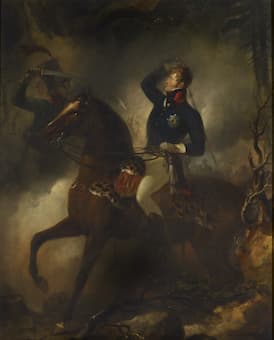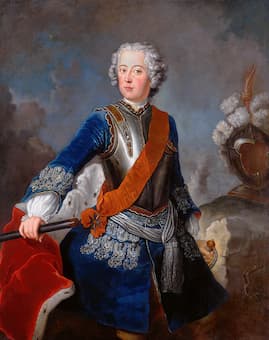
Jean-Laurent Mosnier: Prince Louis Ferdinand of Prussia, 1799
Berlin-born Louis Ferdinand of Prussia (1772-1806) was a nephew of Frederick the Great. He was active in the Prussian military, serving as lieutenant general. He died in battle with French forces at the Battle of Saalfied, during the War of the Fourth Coalition.
Musically, he was a pianist and a composer. His early pieces were performed by the orchestra of his uncle, Prince Henry. In the salons of Berlin, he was frequently found improvising at the piano. One sign of the regard in which his piano playing was held was the dedication by Beethoven of his third piano concerto to him. Beethoven commented that his playing ‘was not the one of a King or Prince but of a skilled pianist.’

Peter Edward Stroehling: The Death of Prince Louis Ferdinand
of Prussia (Royal Collection, UK)
Growing up, the court of Frederick II and that of his aunt, Princess Anna Amelia, provided a music-intense background for him. It is said that he frequently played his keyboard works on the Princess’ piano or organ. We shouldn’t forget that Anna Amelia was also a composer. His performing skills were what he was best known for; it was only later that his compositional prowess was recognized. His compositional output is numbered at 13 pieces, ranging from works for piano and orchestra, piano quintet, piano quartet, piano trio, and piano solo to a nocturne for flute, two horns and piano quartet. Only the Opus 1 Piano Quintet was published in his lifetime. Opp. 2-6 and 10-11 (piano trios, quartets, and a quintet) were published in 1806, op. 7 (a Fugue for piano solo) 1807, Opp. 8-9 and 12 (works for larger ensembles) in 1808, and his last work, the Rondo No. 2 in E flat major for piano and orchestra, appeared in 1823.
His works, such as the Piano Trio in A-Flat major, Op. 2 have a style and lightness that distinguishes him from being just any amateur player.
Louis Ferdinand (Prince of Prussia): Piano Trio in A-Flat Major, Op. 2 – I. Allegro moderato (Berlind Göbel Trio)
When he writes works for larger ensembles, such as his Rondo No. 1 for piano and orchestra, op. 9, he’s skillful at bringing out the characteristics of each part of the ensemble.
Louis Ferdinand (Prince of Prussia): Rondo in B-Flat Major, Op. 9 (Horst Göbel, piano; Filharmonia Pomorska; Takao Ukigaya, cond.)
In writing his Nocturne, he was picking up on ‘party’ genres of his day – music written for evening parties. This isn’t the same as the new nocturnes created by John Field and popularized by Chopin.
Louis Ferdinand (Prince of Prussia): Nocturne in F Major, Op. 8 (Matthias Perl, flute; Berlin Göbel Trio; Berlin Radio Symphony Orchestra)
Louis Ferdinand’s music lived on in a work by Franz Liszt in 1842. According to the story, Liszt was presented with an album of the works of Prince Louis Ferdinand that had been published by Erard. He chose the melodies he used in his Élégie from the album. He first published his Élegie sur des motifs du Prince Louis Ferdinand de Prusse in 1843, and then revised it and republished it in 1852.
Franz Liszt: Élégie sur des motifs du Prince Louis Ferdinand de Prusse, S168/R75 (Jenő Jandó, piano)
This painting of the death of Louis Ferdinand in battle was probably commissioned by King George IV of England. The painter, Peter Edward Stroehling, was styled as ‘Historical Painter to the Prince of Wales’ between 1810 and 1820. He was killed in combat by Jean-Baptiste Guindey, quartermaster of the French 10th Hussars.
For more of the best in classical music, sign up to our E-Newsletter





